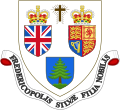 | |
| Established | 1994 |
|---|---|
| Location | 668 Brunswick Street Fredericton, New Brunswick E3B 1H6 |
| Type | science museum |
| Director | Harry Palmer |
| Curator | David Desjardins |
| Website | http://www.scienceeast.nb.ca/ |
Science East is an interactive science museum located in Fredericton, New Brunswick, Canada. It uses interactive science exhibits to demonstrate basic science concepts. The museum also features travelling exhibits which tour the province. It was founded in 1994, and since 1999 it has been accommodated in what used to be the York County jail. Constructed in 1842, the jail constitutes a tourist attraction in itself.[ citation needed ]
